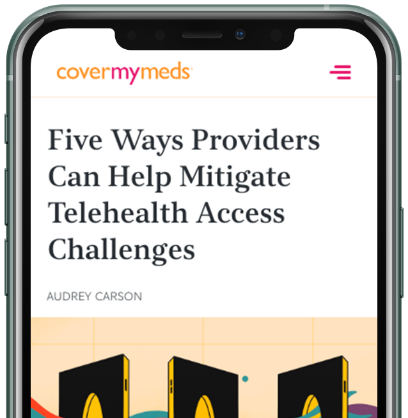Five Ways Providers Can Help Mitigate Telehealth Access Challenges
Telehealth has settled in as a new mainstream method for accessing healthcare — 66% of patients in a recent survey who used telehealth as a result of the COVID-19 pandemic said they are more likely to use it moving forward.CoverMyMeds COVID-19 Patient Survey, 2020

While many embrace the convenience and speed telehealth can deliver, providers have noticed some challenges. In a recent survey of over 2,700 providers, 80% listed patients’ lack of technology skills as a telemedicine challenge.CoverMyMeds COVID-19 Provider Survey, 2020 As the industry moves forward with telehealth, there are opportunities listed below to help ease the transition early in the patient journey.
Meet patients where they are
While change is inevitable, researchers have found that relying on existing routines and convenience helps build out the architecture of habits.For Habits, the Strategy of Convenience One strategy may be to layer in telehealth appointment instructions in places they’re in a habit of using: patient portals, apps and practice websites with integrated technology can help mitigate the fear of the unknown and smooth the process.
This may also mean using a familiar technology, depending on the patient. Studies suggest seniors may be more comfortable using phones for audio-only visits. In a recent study of over 500 patients, nearly 40% listed phone calls as their first choice for a healthcare virtual communication tool.CoverMyMeds COVID-19 Patient Survey, 2020
In an April survey on COVID-19 healthcare behaviors, just over 10% of seniors had used video to communicate with a provider, despite over two thirds having access to the technology.Why We Should Use Telemedicine for Follow-Up Care, eVisit, 2020 But maybe they just needed the opportunity to try it: Of those who did use telehealth to access a provider, 91% reported a favorable experience.Why We Should Use Telemedicine for Follow-Up Care, eVisit, 2020 Encouragement and testimonials from trusted friends, family and perhaps other patients could help ease the transition for some into virtual appointments.
In some cases, by using a technology patients are already comfortable with, both providers and patients save time, and patients avoid frustrations that may prevent them from adhering to future appointments.
Provide instructions in clinical discharge summaries
Many electronic health record (EHR) systems allow offices to customize clinical visit summaries. While some medical conditions may still merit a physical in-office exam, many clinicians encourage virtual follow-up appointments for speed and convenience of these often less invasive visits.Why We Should Use Telemedicine for Follow-Up Care, eVisit, 2020 Discharge paperwork could easily include personalized instructions for accessing the scheduled virtual follow-up appointment. This could also include frequently asked questions regarding telehealth appointments and troubleshooting tips. Check with your EHR vendor about options for your patients.
Focus on the user experience more than technology
For provider offices who already had telehealth integrations in place, anecdotal interviews show that the conversion was relatively easy when COVID-19 forced many offices to make the switch. Systems were in place and the user experience was seamless. For the 85% of providers surveyed who had to start telehealth,CoverMyMeds COVID-19 Provider Survey, 2020 the transition came with some bumps in the road. Reimbursement hiccups, lack of integration into current technology, user errors and privacy concerns were among the top complaints of providers who switched to telehealth appointments.
“Poorly implemented technology with a poor user experience creates challenges for patients,” said Mark Lorenz, Vice President, Patient Solutions at CoverMyMeds. “It’s not the technology itself, it’s how easy you make it to use.”
Through recent user interviews, Lorenz and his team have found providers had most success when patients had a user experience that allowed them to click right into an appointment, avoiding wading through login screens and enrollments. When choosing a telehealth platform, user experience and integrations can be critical to adoption.
Remove administrative barriers where you can
In many telehealth appointments, providers are not only performing their typical duties, but they're also responsible for collecting information such as a patient’s preferred pharmacy, medication history and even administrative billing duties. In some cases, providers have seen more patients simply willing to pay cash for the appointments to get them done.
Integrations with automated services can help lift the burden of these small tasks so providers can spend more time connecting with patients. Prescription assistance tools such as ScriptHero can help automate the pharmacy selection and payment process so patients can feel empowered by choice — and providers can practice medicine.
Consider social determinants of health
Of patients surveyed, most listed convenience as a helpful aspect of telehealth.CoverMyMeds COVID-19 Patient Survey, 2020 However, depending on the living situation, geographic location and resources available to patients, this may not always be the case. Those in rural areas with little to no broadband access are also often those who are the farthest from their health providers, further marginalizing them from healthcare access. Others simply may not have the means to pay for internet service, and with many public wifi areas still unavailable due to COVID-19, they may not have another means of technology access.
Lorenz points out that some patients may have always had trouble scheduling and getting to healthcare appointments. While physically getting to appointments may no longer be the challenge, technology challenges can happen — and that’s what doctors are now seeing.
“It was invisible to them before, but it’s now visible,” Lorenz said. “With telemedicine, getting there isn't a challenge anymore. Sure, there will be technology blips, but those may be better than the challenges of coordinating travel.”
For these current challenges, services such as virtual networks with peers, team-based care, in-home monitoring and patient education can be helpful. Providers can also visit the National Consortium of Telehealth Resource Centers for resources specific to their area of practice.
And for more help on medication access challenges at the point of prescribing, contact us for more information.
The latest healthcare insights, floated right to your inbox.



